Edge computing has emerged as a game-changer for organisations across various industries. By processing data closer to the edge devices, such as IoT sensors, autonomous vehicles, and industrial machinery, businesses can overcome latency issues, reduce bandwidth consumption, and enhance the performance of critical applications. This distributed approach to data processing enables real-time decision-making, improved security, and increased operational efficiency. However, the implementation of this distributed strategy does present its fair share of challenges.
The challenge of fragmented edge environments
Implementing an effective edge computing strategy can be exceptionally challenging due to the inherently fragmented nature of edge environments. The diverse range of edge deployments introduces a multitude of variables, including unique location requirements, infrastructure constraints, and specialised needs. Whether it’s a remote industrial site, a bustling urban IoT deployment, or a geographically dispersed network of edge devices, each scenario demands careful consideration and customisation to ensure optimal performance. This fragmentation inevitably leads to complexities in deploying and managing edge infrastructure across multiple locations, presenting significant obstacles for organisations aiming to achieve a cohesive and efficient edge computing strategy.
The variability in edge environments poses a considerable challenge in terms of coordination, resource allocation, and operational coherence. With each edge deployment having its distinct set of requirements, organisations often find themselves navigating a maze of disparate infrastructure, connectivity options, and operational procedures. This lack of standardisation not only increases costs but also hampers the ability to implement consistent processes, monitor performance effectively, and respond swiftly to potential issues.
Furthermore, without standardisation, organisations may face difficulties in leveraging economies of scale and optimising resource utilisation. The absence of a standardised approach hinders the ability to leverage common infrastructure components, implement unified monitoring and management tools, and achieve seamless integration with existing systems. As a result, organisations may find themselves grappling with excessive complexity, redundant resources, and a lack of operational visibility.
The Power of Standardisation
Standardisation brings numerous benefits to edge computing strategies, making them more scalable, manageable, and cost-effective. Let’s explore some of the advantages:
1. Simplified Deployment – Adopting standardisation allows organisations to streamline the deployment process across different edge environments. By following a consistent approach, businesses can save time and effort in planning, installation, and configuration, ensuring a smooth and efficient deployment experience.
2. Cost Efficiency – Standardisation enables economies of scale, reducing costs associated with customisation and site-specific requirements. By using standardised solutions, organisations can achieve significant cost savings through streamlined procurement, deployment, and maintenance processes.
3. Scalability and Flexibility – A standardised edge computing strategy ensures seamless scalability and flexibility as businesses expand their edge footprint. With a consistent and versatile solution, organisations can easily replicate deployments across multiple edge locations, ensuring interoperability, minimising compatibility issues, and simplifying expansion efforts.
4. Streamlined Monitoring and Management – With a standardised approach, organisations can smoothly implement centralised monitoring tools, providing real-time visibility into each edge deployment. This centralised management simplifies administration, enhances troubleshooting capabilities, and enables proactive maintenance, ensuring optimised performance across the entire edge infrastructure.
The perfect solution for standardised edge networks
Zella DC’s micro data centres are specifically designed to address the challenges of edge computing in a standardised manner. The whole product suite is built upon the foundation of the Zella Pro, an edge-ready micro data centre strategically created to adapt to any industry and environment.
By using this edge-ready standardised solutions, companies will be able to easily implement a standardised edge computing strategy with the following benefits:
 Simplified Deployment with a standardised approach to deployment, that ensures a streamlined and efficient process across different edge environments. With their modular and pre-integrated design, our indoor, outdoor, and containerised data centres can be easily installed, saving time and effort in planning, installation, and configuration, eliminating the need for customised solutions.
Simplified Deployment with a standardised approach to deployment, that ensures a streamlined and efficient process across different edge environments. With their modular and pre-integrated design, our indoor, outdoor, and containerised data centres can be easily installed, saving time and effort in planning, installation, and configuration, eliminating the need for customised solutions.
 Cost Efficiency: a consistent product and standardised procurement processes, means organisations can optimise their procurement, deployment, and maintenance processes, reducing costs associated with customisation and site-specific requirements.
Cost Efficiency: a consistent product and standardised procurement processes, means organisations can optimise their procurement, deployment, and maintenance processes, reducing costs associated with customisation and site-specific requirements.
 Scalability and Flexibility: as organisations expand their edge footprint, these micro data centres can be easily replicated and deployed across multiple edge locations. The standardised nature of the micro data centres ensures interoperability and minimises compatibility issues, simplifying expansion efforts and enabling seamless scalability. This also eliminates the complexities of managing diverse infrastructure solutions.
Scalability and Flexibility: as organisations expand their edge footprint, these micro data centres can be easily replicated and deployed across multiple edge locations. The standardised nature of the micro data centres ensures interoperability and minimises compatibility issues, simplifying expansion efforts and enabling seamless scalability. This also eliminates the complexities of managing diverse infrastructure solutions.
 Streamlined Monitoring and Management with products designed to integrate seamlessly with centralised management systems thus enabling efficient administration, enhanced troubleshooting capabilities, and proactive maintenance. Centralised monitoring and management ensure optimised performance across the entire edge infrastructure, reducing operational complexities and enabling proactive decision-making.
Streamlined Monitoring and Management with products designed to integrate seamlessly with centralised management systems thus enabling efficient administration, enhanced troubleshooting capabilities, and proactive maintenance. Centralised monitoring and management ensure optimised performance across the entire edge infrastructure, reducing operational complexities and enabling proactive decision-making.
Standardisation clearly plays a crucial role in overcoming the challenges posed by the fragmented nature of edge environments. By embracing a standardised edge computing strategy and leveraging intelligent edge-ready solutions, organisations can unlock the full potential of edge computing while simplifying deployment, reducing costs, and ensuring efficient monitoring and management across diverse edge deployments.






